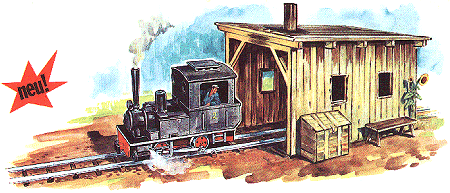History I

Historical sources concerning the EGGER company and its products are rather scarce, and most of what was written is now at least 20 years old. Apart from the Mikado »Handbuch für Modellbahn-Sammler: EGGER-BAHN« of 1988/89 (in German only) the only known documentation seems to be a handful of articles that appeared over the years in German model railway magazines. An overview of this meagre body of information (the Mikado »Handbook« is itself a rather thin volume) gives the impression that a lot of copy was borrowed from the first few articles and simply repeated thereafter. With the passage of time, many things can no longer be definitively proved or disproved, but rumours and gossip may have come to be accepted as truth because by now, »everybody's heard it«.
On this website, I've attempted to separate fact from fiction and piece together a little history of the EGGER Company. This was no simple task and, given the limits of the historical sources, the resulting biography remains a work in progress. However, personal interviews with individuals directly involved with the EGGER firm at the time were invaluable in shedding light on some of these topics...

In 1963, three brothers with the common South German surname of Egger founded a model railways factory in Munich. The family name, combined with the word »Bahn« (»railway« in German) gave rise to the company name EGGER-BAHN. Very early on one of the three gave up his share of the business, leaving the fledgling firm in the hands of mechanical engineer Theodor Egger and businessman Johann Egger.
What made EGGER-BAHN so revolutionary was that a narrow gauge industrial railway in HO (1:87) scale on 9mm gauge track had never been offered before. Known today as HOe or HOn30, these models represent a real-life gauge of 750 mm. It's important to note that this is not the same thing as N gauge, which also runs on 9mm track but represents standard gauge prototypes in 1:160 scale. Even though the interval between sleepers is completely different on these two systems (with EGGER-BAHN there are fewer sleepers, spaced much further apart) the identical track gauge can make them easy to confuse at first.
After making a big splash at the 1963 Nuernberg Toy Fair the model range quickly grew to include not just purely industrial equipment, but also narrow gauge passenger coaches and small branch line locomotives. In 1966, the »EGGER-Lectron« system of electronic component blocks for young experimenters was launched. This highly innovative venture outside the realm of model railways was passed on later to the the famous Braun company.

Initial sucesses spurred the young company to expand, but a way to fund that expansion had to be found as well. As early as 1964 the brothers had to take on financial partners for whom model railways were a means to an entirely different end. Shortly after joining the firm, partners from Constantin Films began unabashedly to stamp their interests on the EGGER product line. Whereas all previous models had been based on real-life prototypes, the »Western Train« was pure fantasy, in effect a promotional gimmick for Constantin's »Winnetou« and »Old Shatterhand« movies, popular westerns of the time.
Dedicated railway modellers wanted little to do with these new »toy« items, and when sold as toys the tiny trains were quickly broken by children's rough handling. On top of that, the newly-introduced »Magna-Kraft« feature, an attempt to boost the featherweight locomotives' traction using magnets, was a complete flop due to sloppy production tolerances. Finally, conflict between the quality-conscious EGGER brothers and their profit-motivated backers from the film company, coupled with ongoing difficulties manufacturing the drive systems led to the end of production and the breakup of the firm in 1967.

Somewhat later the French firm Jouef acquired the EGGER-BAHN tooling and dies, began marketing the leftover stocks of original EGGER models and started manufacturing its own replica line. Unfortunately, quality control (especially with the new motors) suffered even more under Jouef, and as a result the replicas are not particularly prized today.
The engineering partner Theodor Egger, forced out of his own firm amid hostile maneuverings, wowed the model scene once again with an ingenious system of ship models moving on real water, in 1:160 scale. A paddlewheel steamboat packing enough battery power for 10 hours of »steaming« steered a flawless and utterly convincing course around model lakes. The secret: an extremely thin linkage following transparent guide rails, virtually invisible underwater. Yet for all its technical sophistication the ship system was never granted a patent, and Theodor Egger finally moved on to the field of scientific research: as a technical specialist he took up the study of »Factors Affecting Visibility from Inside Motor Vehicles«.